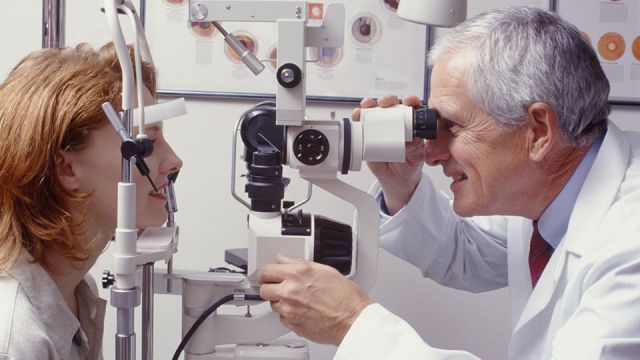
When it comes to looking into your eyes, seeing is believing. And what doctors can see from a single eye exam are diseases that affect the entire body. Some are things you can even see by simply looking in the mirror. Your eyes can show signs of diabetes, high cholesterol, potential aneurysms, thyroid disease and more. So, read on to find out what your eyes say about your health.
Abnormal shape and color of blood vessels
In a report from the Independent, Dr. Neal Adams talks about disorders and diseases ophthalmologists can detect during a simple eye exam. For instance, if your doctor suspects you have high-blood pressure, there’s a good reason he or she may want to look into your eyes first.
According to Dr. Adams, an abnormality in shape and color of your blood vessels can show signs of cardiovascular disease such as high blood pressure. Ophthalmologists can even see blood cells flowing through tiny blood vessels in the eye. Looking at the back of the eye reveals whether or not your small blood vessels have thickened, narrowed or burst. In fact, this is the only way small blood vessels can be viewed. And, problems here may be repeated in small blood vessels in places that can’t be seen, like the kidneys, says Blood Pressure Uk.
Gray ring around the cornea
If you have a gray ring around the edge of the cornea, doctors call this arcus senilis. This gray ring often goes hand-in-hand with high cholesterol and triglycerides, as well as an increased risk for heart attack and stroke. Arcus senilis is very common, affecting about 60 percent of people between the ages of 50 and 60 and nearly 100 percent of people over 80. But, according to Troy Bedinghaus, OD for Very Well, most eye doctors believe that anyone under the age of 50 who has this condition should have their blood tested to check for elevated cholesterol levels or other lipid disorders.
Bulging eyes

Grave’s disease or hyperthyroidism is an immune system disorder that results in the overproduction of thyroid hormones. And about 30 percent of people with Grave’s show signs and symptoms of a condition known as Graves’ ophthalmopathy. Telltale signs of this disease usually result in weight loss, nervousness and a rapid or irregular pulse. But it also shows up in the eyes, producing bulging or a bug-eyed look. You may also feel a gritty sensation in the eyes, pressure and pain, and puffy or retracted eyelids, says the Mayo Clinic.
Pupils of different sizes
If you look in the mirror and notice that one pupil is larger than the other, then see your doctor fast, suggests Dr. John C. Hagan, III, ophthalmologist for CBSN. Often accompanied by droopy eyelids, pupils of different sizes are referred to as Horner’s syndrome. This potentially dangerous condition is sometimes associated with aneurysms and tumors in the neck.
Growth on or in the eye
Sometimes cancer that grows in the body shows up in the eyes first. The two most common cancers that appear in an eye are breast cancer in women and lung cancer in men. That’s because malignant tumors from other parts of the body can spread in and around the eye. These secondary malignant growths may never be discovered unless they affect vision, are visible to the patient or push the eye forward, according to Dr. Paul T. Finger for New York Eye Cancer Center.
Cloudy eyes

If the normally clear lens of your eye becomes cloudy and opaque, then you may have cataracts according to Doctors of Optometry. Cataracts can vary from extremely small areas of cloudiness to larger opaque areas that cause a noticeable blurring of vision. Cataracts are generally the result of aging changes that cause the lenses to become cloudy. While you can’t prevent cataracts from forming, wearing sunglasses can certainly help protect your eyes from harmful UV rays, which can speed up cataracts. A diet rich in antioxidants like vitamins A, C, E, zinc, selenium and magnesium may also help keep eyes clearer.
Floaters and flashes
Floater refers to the specks, threads or cobweb-like images that you occasionally see drifting across the line of vision. Floaters move as your eyes move, and zoom away when you try to look directly at them. Similar are flashes of light that flicker across your visual field. Both are usually more of a nuisance than harmful. But, sometimes floaters and flashes signal a condition that can lead to vision loss, according to Harvard Health.
“A new onset of floaters may herald retinal disease,” suggests Dr. Jeffrey Heier, director of the retina service at Ophthalmic Consultants of Boston and clinical instructor in ophthalmology at Harvard Medical School. If you experience any of these warning signs, call your doctor right away: Sudden floaters and flashes of light in the eye, gradual shading of vision like a curtain being drawn, or sudden decline in sharp, central vision.
It doesn’t matter how old you are, or how physically fit you appear, you should have an annual comprehensive eye exam. An optometrist or ophthalmologist can help detect any potential eye problems — and certain health issues throughout your body — at their early stages when they’re most treatable.
— Katherine Marko

